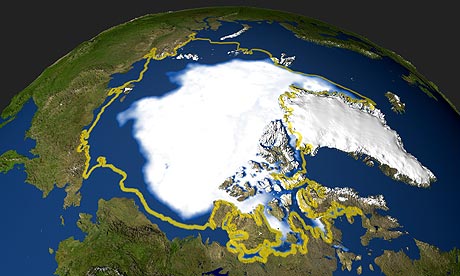by: David Adam
Much of the record breaking loss of ice in the Arctic ocean in recent years is down to the region's swirling winds and is not a direct result of global warming, a new study reveals.
Ice blown out of the region by Arctic winds can explain around one-third of the steep downward trend in sea ice extent in the region since 1979, the scientists say.
The study does not question that global warming is also melting ice in the Arctic, but it could raise doubts about high-profile claims that the region has passed a climate "tipping point" that could see ice loss sharply accelerate in coming years.
The new findings also help to explain the massive loss of Arctic ice seen in the summers of 2007-08, which prompted suggestions that the summertime Arctic Ocean could be ice-free withing a decade. About half of the variation in maximum ice loss each September is down to changes in wind patterns, the study says.
Masayo Ogi, a scientist with the Japan Agency for Marine-Earth Science and Technology in Yokohama, and her colleagues, looked at records of how winds have behaved across the Arctic since satellite measurements of ice extent there began in 1979.
They found that changes in wind patterns, such as summertime winds that blow clockwise around the Beaufort Sea, seemed to coincide with years where sea ice loss was highest.
Writing in a paper to be published in the journal Geophysical Research Letters, the scientists suggest these winds have blown large amounts of Arctic ice south through the Fram Strait, which passes between Greenland and the Norwegian islands of Svalbard, and leads to the warmer waters of the north Atlantic. These winds have increased recently, which could help explain the apparent acceleration in ice loss.
"Wind-induced, year-to-year differences in the rate of flow of ice toward and through Fram Strait play an important role in modulating September sea ice extent on a year-to-year basis," the scientists say. "A trend toward an increased wind-induced rate of flow has contributed to the decline in the areal coverage of Arctic summer sea ice."
Ogi said this was the first time the Arctic winds have been analysed in such a way.
"Both winter and summer winds could blow ice out of the Arctic [through] the Fram Strait during 1979-2009," she said.
A number of other factors were also responsible for ice loss, including warming of the air and ocean, she added.
According to the National Snow and Ice Data Centre in Colorado, Arctic sea ice "is in a state of ongoing decline". Since 1979, the ice has shrunk by about 10% a decade, or 28,000 square miles each year. The ice reaches its minimum extent each September, when it begins to reform as the freezing Arctic winter takes hold.

No comments:
Post a Comment